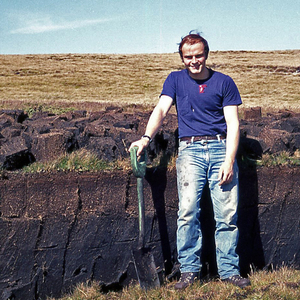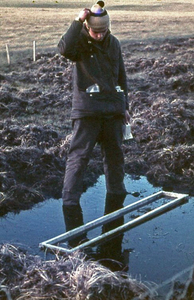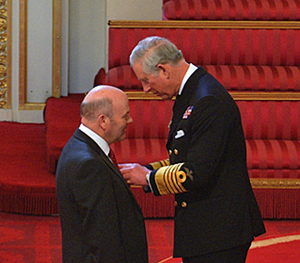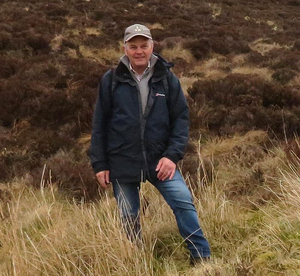McADAM, JAMES HENRY (Jim)
b.1952 from Ireland
agronomist, agricultural and environmental scientist, was born in Donaghadee, County Down on 15 January 1952, the only son of Fred and May McAdam. He attended Ballywalter Primary School and Coleraine Academical Institution and was an undergraduate at Queen’s University Belfast (QUB) from 1969 to 1974, undertaking degrees in botany and honours in agricultural botany (1st).
McAdam’s first encounter with the Falklands came in 1969 when, as a young university student, he bought a second-hand copy of the Uttermost Part of the Earth by Lucas Bridges in a local church bazaar. He was absolutely fascinated by the story and subsequently read up more on the Falklands. Since then, he counts himself extremely fortunate to have spent many memorable days staying and working on Keppel Island, particularly with good friends Sam and Hay Miller, and subsequently was privileged to enjoy the friendship and collaboration of the Goodall family, staying several times at Estancias Harberton and Viamonte on Tierra del Fuego.
In 1975 while undertaking a PhD, he saw an advert for a pasture agronomist position in the Falkland Islands. Having, by then, a deep interest in islands and hill farming and being well read and informed about the Falklands (he had written to Chief Secretary Doug Morrison in 1972 about the prospects for working in the Islands - the letter was still on file when he arrived four years later) he applied, more in hope than expectation, as the position required applicants with much more experience than he had. However he was successful in the competition and, in January 1976, he and his wife Sally neé Gibson (1954-2013) set off for the Falklands. It was a time of increased tension between Britain and Argentina, the SHACKLETON Survey Team were in the islands. McAdam had the privilege of accompanying the team on some of their agriculture-related visits and later in his posting was involved in drawing up vegetation maps to calculate stock carrying capacity and hence assist in drawing up farm boundaries as part of the process of sub-division.
The history of agricultural research and development in the Falklands is a long one – going back as far as Governor MOODY and various individuals in between who had reported on and carried out trials of one sort or another. Probably the most significant visit of all was that funded by the then Overseas Development Administration in 1969. A team of agricultural specialists led by Tom Davies produced a major report which recommended the establishment of a permanent agricultural research unit in the Islands which would have the capacity to conduct field trials on which to base their advice. One of their main tasks was to test the application of emerging research carried out by the UK’s Hill Farming Research Organisation in Scotland. Their work, particularly on integrating sheep nutritional requirements with pasture quality and growth into what became known as the ‘two pasture system of hill sheep management’ was a huge advance in hill sheep farming in the UK and became the central core of the research unit established in the Falklands – the Grassland Trials Unit (GTU). The unit’s task was also to quantify the resource and to research ways of increasing productivity, largely through the introduction of developments in animal nutrition, native pasture ecology, reseeding and hill sheep grazing systems currently being implemented in the British Isles. In 1974 Campbell Kerr was appointed as leader of the GTU and McAdam was appointed in December 1975 as Pasture Agronomist for 3 years. The GTU was located in what was the Met Office, later with refurbishment and additions to become the building that houses the current Department of Agriculture.
McAdam fully immersed himself in life in the Falklands in the 1970s. He loved the challenge of camp driving and the independence and community involvement which the Falklands gave him and his family. He soon struck up a friendship with Falkland Islander Owen Summers, then a young Met Officer who shared the office with the GTU team. Owen showed him how to cut peat, carve up a mutton carcass, what to grow in his garden and he and wife Veronica led the McAdams on some great Land Rover expeditions around remote corners of East Falkland. They remained friends for life, both Owen and Veronica sadly passing away in recent years. For a young scientist McAdam had the great feeling that everything he tried, did and measured was actually new and could be used in developing a better future for farming in the Islands. He felt a great pioneering spirit in all that he did, particularly benefitting from being able to travel around the full range of farms. He made many close friends in the Islands and enjoyed the opportunity to meet up with them where possible on his many visits to the Falklands after 1983.
He had been a keen soccer player at university and greatly enjoyed the opportunity to play in the local league in Stanley. He was goalkeeper for Redsox over two seasons and was fortunate to be able to play for the national team on several occasions. According to the then veteran Stanley manager Doley Williams the only reason for not automatically selecting him more was that he clearly made up for lack of height by a reckless fearlessness in goal which was likely to result in him being carried off well before the end of any match! He was also able to keep up his interest in sub-aqua diving by participating in some memorable dives with friends Vernon Steen and Owen Summers. McAdam and visiting student geologist Dave Roberts planned and executed an expedition in 1978 to explore the bottom of the Black Tarn on Mt Usborne. This dispelled local myths that it was either bottomless or that its level went up and down with the tide and secured a valuable sediment core from the bottom which helped date the duration of the last ice age and subsequent post glacial vegetation history of the Falklands (see 1981 Falkland Islands Journal).
He, Sally and daughter Emma Jane (b 1977 in Stanley) left the Falklands in July 1978. He adapted his basic short wheel-base Land Rover for cramped living, had it shipped across to Buenos Aires (on the Bahia Buen Succeso) and, in company with Dr Derek Cox and his family spent six months driving up through the highways and byways of southern South America.
On return to Northern Ireland, McAdam was appointed Hill Land Research Officer within the Department of Agriculture and in 1982 he was also appointed (concurrent position) as a lecturer in agricultural botany at QUB. In 1983 he was asked by the then United Kingdom Falkland Islands Trust (UKFIT) to revisit the Islands as their consultant to assess how the Trust could support FIG in particular areas. Initially these were biological husbandry, expanding into seaweed use, tree planting for shelter, Tussac grass establishment and native pasture management. More recently he contributed to projects on the potential impact of climate change in the Falklands and the mapping of the distribution and extent of soil and peat in the Islands. This started him on what became annual visits to the Falklands working closely with the Department of Agriculture, assisting in many areas of the agronomy programme and continuing research interests in the Falklands combining support from UKFIT and his position in QUB to encourage several significant postgraduate studentships on mainly grassland and environment-related topics. He was appointed honorary professor in the University of Magallanes in Punta Arenas in 1995 and encouraged the sharing of information and technology between the Magallanes region and the Falklands through student exchanges and research visits.
McAdam considers himself very fortunate in having experienced life in the Falklands over 46 years, through the most significant event in camp life in the islands - farm sub-division - and through what he still looks back on as the darkest moment in the colony in those days - the sad events surrounding the Beaver crash in 1976 and the death of Ian CAMPBELL. McAdam played a part in the subsequent search and recovery operation, which had a lasting effect on him, and, on reflection, bonded him with the local community. He and Owen Summers felt it important that the full story behind the official version of the crash and subsequent search should be told. Following detailed research and talking to those who were still around and had been involved, they documented the story in the 2009 issue of the Falkland Islands Journal.
He always had a deep interest in local history and from the mid-1980s assisted the late Sydney MILLER in editing and producing the Falkland Islands Journal which had been founded by the Colonial Secretary, Tommy THOMPSON in 1967. In 1974 Miller had rescued the Journal from virtual demise. McAdam was deeply honoured when, in 1990, Miller handed over the editorship of the Journal to him. The 31 issues he has produced and the path he has taken to develop the quality, reputation and scope of the Journal, particularly its alignment with the Falkland Islands Museum and National Trust, have given him great satisfaction and have brought him into contact with some of the most interesting people he has been privileged to know.
He has published 31 refereed scientific papers on the Falklands and many other papers on all aspects of his involvement in the Islands - many of them with students and colleagues he has worked with over the years (see Bibliography attached). He has co-authored a book on the Upland Goose with Ron SUMMERS and on Wildflowers of the Falkland Islands with Tom Davies. He regularly gives illustrated talks and lectures on all aspects of the Falkland Islands. In 1982, through the Extra-Mural Department in QUB, he ended up having to present a 10-weekly talk series on the Falklands at four different venues in Northern Ireland, a task which sorely tested his photographic collection and powers of recall!
McAdam sits on the academic selection committee of the Shackleton Scholarship Fund and is a committee member of the Friends of the Museum and Jane Cameron National Archives.
He was elected Fellow of the Royal Agricultural Societies (2005) and awarded the OBE (in 2014) for his contribution to agriculture and research in the Falkland Islands. Since retirement from his government post in 2018, he has continued his active involvement in the Falklands, contributing to research projects, acting as consultant to the Falkland Islands Trust and editing the Falkland Islands Journal. He is the keeper of a considerable archive of books, papers and other publications on the Falklands.
Jim McAdam has two children by his first marriage - Emma Jane (b 1977) and Thomas (b 1980). He married Geraldine McDonald in 2010 and has continued an active interest in all aspects of life in the Falkland Islands.
References
Bibliography:
Refereed papers
McADAM, J.H. (1980).Tatter flags and climate in the Falkland Islands. Weather, 35, 321-327.
McADAM, J.H. (1980). Uncontrolled grazing and vegetation removal in the Falkland Islands. Environmental Conservation,7, 201-202.
McADAM, J.H. (1981). The effect of lime and phosphate on soils and sown species in the Falkland Islands. Journal of Agricultural Science, Cambridge, 96, 89-97.
McADAM, J.H. (1982). Recent tree planting trials and the status of forestry in the Falkland Islands. Commonwealth Forestry Review, 61 (3), 259-267.
McADAM, J.H. (1984). Recent developments in Falkland Islands’ Agriculture. Interciencia, 9, 307-310.
McADAM, J.H. (1984). The introduction of Holcus lanatus by direct drilling following burning of native grassland in the Falkland Islands. Research and Development in Agriculture,1, 165-169.
McADAM, J.H. (1985). The effect of climate on plant growth and agriculture in the Falkland Islands. Progress in Biometeorology, 2, 155-176.
McADAM, J.H. (1986). Growth and production of a Cortaderia pilosa (Gramineae) community in the Falkland Islands. Grass and Forage Science, 41, 281-287.
McADAM, J.H. (1987). The contribution of settlement schools to pasture improvement studies in the Falkland Islands. Agricultural Progress, 62, 97-104.
McADAM, J.H. (1988). The potential for biological husbandry in the Falkland Islands. Modern Organic Farming and Horticulture, 1, 9-11.
McADAM, J.H. (1989). Seaweed in the Falkland Islands and its potential role in agriculture. Natural Farming, 1, 15-19.
HOPPÉ, G.M. and McADAM, J.H.* (1992). Management of a Tussac grass community for wildlife, tourism and agriculture. In: Vegetation Management in Forestry, Amenity and Conservation Areas. Aspects of Applied Biology,29, 377-381.
ZAHEER, K., FLEMING, C., TURNER, S.J., KERR, J.A. and McADAM, J.H. (1992). Genetic variation and pathotype response in Globodera pallida (Nematoda: Heteroderidae) from the Falkland Islands. Nematologica, 38, 175-189.
WILSON, P., CLARK, R., McADAM, J.H. and COOPER, E.A. (1993). Soil erosion in the Falkland Islands: a preliminary assessment. Applied Geography, 13, 329-352.
McADAM, J.H. (1996). The current status, threats to and conservation of the flora of the Falkland Islands. Aspects of Applied Biology, 44, 419-424.
POSKUTA, J.W., McADAM, J.H., WACLAWCZYK-LACH, E, and WROBLEWSKA, B. (1998). Photosynthetic and respiratory characteristics of Cortaderia pilosa (D’Urv) Hack., the dominant component of Falkland Islands. Journal of Plant Physiology,153, 517-519.
McADAM, J.H. (1999). The potential of trees to improve the shrubby grasslands of the Falkland Islands. (In: Eds V. Papanastasis, J. Frame and A. S. Nastis. European Grassland Federation Symposium on Grasslands and Woody Plants in Europe. Grassland Science in Europe4, 205-209.
BROUGHTON, D. McADAM, J.H. and BRANNSTRÖM, R. (2000) A combined checklist and ecographic conspectus for the vascular flora of Saunders Island, Falkland (Malvinas) Islands. Anales Instituto Patagonia. Serie Cs. Nat. (Chile) 28, 57-88.
McADAM, J.H., KERR, J.A., FISHER, G.J. and TALLOWIN, J.R.B. (2001). Management for biodiversity in Grassland Farming Systems. Proceedings No 485 International Fertiliser Society, pp 1-27.
WILSON, F.E.A., HARVEY, B.M.R., McADAM, J.H. and WALTON, D.W.H. (2001). The response of Whitegrass (Cortaderia pilosa (D’Urv.) Hack to nitrogen nutrition. Grass and Forage Science,56 (1), 84-91.
BROUGHTON, D.A. & McADAM, J.H. (2002). A preliminary red data list for the Falkland Islands vascular flora. Oryx, The International Journal of Conservation, 36(3), 1-10.
BROUGHTON, D.A. and McADAM, J.H. (2002). The Non-native vascular flora of the Falkland Islands. Botanical Journal of Scotland54 (2) 153-190.
BROUGHTON, D.A., McADAM, J.H. (2003). The current status and distribution of the Falkland Islands pteridophyte flora. The Fern Gazette, 17(1), 19-36.
BROUGHTON, D.A. & McADAM, J.H. (2005). A checklist of the native vascular flora of the Falkland Islands: New information on the species present, their ecology, status and distribution. Journal of the Torrey Botanical Society 132 (1), 115-148..
DAHLIN, A.S., EMANUELSSON, U. & McADAM, J.H. (2005). Nutrient management in low input grazing-based systems of meat production. Soil Use and Management21, 122-131.
OLAVE, R. & McADAM, J.H. (2005). The effect on height, diameter form and flowering of oak (Quercus robur) and Southern Beech (Nothofagus pumilio) plants grown by the Root Production Method (RPM). Simiente74 (3-4).
McADAM J.H. & BROUGHTON, D.A. (2011). The current status of and threats to the vascular flora of the Falkland Islands, South Atlantic. Anales del Instituto de la Patagonia 39(1): 103-108.
McADAM J H (2013)The impact of the Falklands War (1982) on the peatland ecosystem of the Islands.In ; Rotherham I & Handley C (eds) War and Peat. Wildtrack Publishing, Sheffield. Landscape Archaeology and Ecology10, 143-162 .
McADAM J H (2014) Farming on the Peatlands of the Falkland IslandsPaper presented and published in :In the Bog - The ecology, landscape, archaeology and heritage of Peatlandsin Sheffield, 4thSept 2014
McADAM J. H. et al (2017) Potential impacts of climate change on native plant distributions in the Falkland Islands PLoS ONE 11(11): e0167026. doi:10.1371/journal. pone.0167026
Other publications.
McADAM, J.H. and ROBERTS, D.E. (1981). The origin of Black Tarn Mount Usborne. The Falkland Islands Journal, pp 23-28.
McADAM, J.H. (1984). Scientific publications relevant to the Falkland Islands. The Falkland Islands Journal, pp 11-15.
McADAM, J.H. (1985). Scientific papers and publications relevant to the Falkland Islands: Part 2, 1983-1984. The Falkland Islands Journal, pp 6-9.
McADAM, J.H. (1986). Scientific papers and publications relevant to the Falkland Islands: 3 (1984-1985). The Falkland Islands Journal, pp 10-14.
Gennard, d. and McADAM, J.H. (1987). A pollen profile from Tussac peat. Sealion Island, East Falkland. The Warrah,3, 4-7.
McADAM, J.H. (1987). Scientific papers and publications relevant to the Falkland Islands: Part 4 (1985-1986). The Falkland Islands Journal, pp 23-25.
McADAM, J.H. (1988). Falkland Islands Agriculture - DANI and QUB involvement. Agriculture in Northern Ireland,3 (3), 16-17.
McADAM, J.H. (1988). Scientific papers and publications relevant to the Falkland Islands: Part 5 (1986-1987). The Falkland Islands Journal, pp 50-54.
McADAM, J.H. (1989). Keppel Island – its current state and importance in the history of the Falkland Islands. Newsletter of the Falkland Islands Foundation, 8, 2-6.
McADAM, J.H.(1989). The great fire on Keppel Island, 1855. The Falkland Islands Journal 1989, 23-28.
McADAM, J.H. (1989). Scientific papers and publications relevant to the Falkland Islands: Part 6 (1988-1989). The Falkland Islands Journal, 1989, 44-47.
PONCET, J., PONCET, S. and McADAM, J.H. (1989). The status of Tussac grass in the Beaver and Weddell Island Groups. Newsletter of the Falkland Islands Foundation, 9, 6-8.
McADAM, J.H. (1991). Scientific papers and publications relevant to the Falkland Islands: Part 7 (1989-1991). The Falkland Islands Journal, 5 (5), 60-65.
McADAM, J.H. (1993). The spider flower, a new plant record for the Falkland Islands. The Warrah,4, 4.
McADAM, J.H. (1994). Scientific papers and publications relevant to the Falkland Islands: Part 8 (1993-1994). The Falkland Islands Journal, 6 (3), 35-44.
McADAM, JIM and WOODS, ROBIN (1995). The flora of Motley Island. The Warrah, 8 (Nov. 1995), 6-7.
McADAM, J.H. (1996). Scientific papers and publications relevant to the Falkland Islands: Part 9, 1994-1996. The Falkland Islands Journal, 6 (5), 124-141.
BROUGHTON, D.A. and McADAM, J.H. (1998). Changes to Falkland Plant names. The Warrah, (Nov 1998) No 14, 4.
McADAM, E.J. and McADAM, J.H. (1998). Captain John McBride of Ballymoney and the early history of the Falkland Islands. Familia, Ulster Genealogical Review No 14, 91-95.
BROUGHTON, D. and McADAM, J.H. (1998). Review of the shrubs of the Falkland Islands. Biology and Environment 98B (1), 39-40. (Abstract).
BROUGHTON, DAVID, and McADAM, JIM (1999). A new native plant for the Falkland Islands and a new endemic. The Warrah No 15 (April 1999), 5.
BROUGHTON, D. and McADAM, J.H. (1999). A note regarding the taxonomic status of the Queen – of – the – Falklands Fritillary in the Falkland Islands. The Falkland Islands Journal 7 (3), 107-108.
BROUGHTON, D. and McADAM, J.H. (1999). Taxonomic changes in the Falkland Islands Vascular Flora. The Falkland Islands Journal, 7 (3), 131-139.
BROUGHTON, D. and McADAM, J.H. (1999). Scientific papers and publications relevant to the Falkland Island: Part 10 (1996-1998). The Falkland Islands Journal, 7 (3), 22-47.
BROUGHTON, D. and McADAM, J.H. (2000). Scientific papers and publications relevant to the Falkland Islands: Part 11 (1999-2000). The Falkland Islands Journal, 7 (4), 18-31.
COULTHARD, F., McADAM, E.J. and McADAM, J.H. (2001). James Lovegrove Waldron – Notebook and original diary 1866-1867. The Falkland Islands Journal, 7 (75) 79-93.
OLAVE, R.J., McADAM, J.H., DAWSON, W.M., KERR, J.A., and LENNIE, G. (2004). Potential use of containerised transplants in the Falkland Islands. USDA Forest Service Proceedings. RMRS-P-33 pp 87-91
McADAM, J. ( 2007) The Shackletons and the Falkland Islands. Nimrod-The Journal of the Ernest Shackleton Autumn School.. Vol 1 :81-92
McADAM, J.H. & ROBERTS, G.(2009) Conor O’Brien. The Falkland Islands Journal 9(3) :33-42
McADAM, J.H. & SUMMERS, O..(2009)The search for Captain Ian Campbell following the crash of Beaver VP-FAK. The Falkland Islands Journal 9(3) : 46-62
McADAM, J. ( 2009) Shackleton and Chile. Nimrod-The Journal of the Ernest Shackleton Autumn School. Vol 3 : 17-38
McADAM, J.& McDONALD, G. (2009).Shackleton’s first 2 public lectures on his return from the Endurance expedition.. Nimrod-The Journal of the Ernest Shackleton Autumn School. Vol 3 : 90-113.
McADAM, J. (2010) Sir Ernest Shackleton and Fur Sealing in the Falkland Islands. Nimrod-The Journal of the Ernest Shackleton Autumn School. Vol 4 :137-150.
McADAM, J. (2011) Shackletonia in the Falkland Islands Journal. Nimrod-The Journal of the Ernest Shackleton Autumn School.. Vol 5 :48-58.
McADAM, J. (2011) A.G.E.Jones-an Appreciation Nimrod-The Journal of the Ernest Shackleton Autumn School.Vol 5 :89-92.
McADAM J (2013) Some uses of remote sensing in land management. Presentation made to the Agronomy Dept, University of Magallanes (by S Radic).
FRERS E, McADAM J. & OLAVE R. (2014) - Tussac Grass. 35th Exposicion y Feria Ganaderia, Rural Association of Tierra del Fuego, 14-16th March 2014.pp 28-31
McADAM J, POOLE, M AND RENDELL N (2016)The Response Of A Small Island State To 1.5°C Climate Change – The Example Of The Falkland Islands. Paper presented at international conference 1.5 Degrees – Meeting the challenge of the Paris Agreement” Oxford University September 2016.
JIM McADAM (Apr 2016) The impact of potential climate change in the Falkland Islands. . Presentation Public Lecture, Chamber of Commerce, Stanley.
JIM McADAM (Feb 2017) The United Kingdom Falkland Islands Trust. PresentationPublic Lecture, Chamber of Commerce, Stanley.
McADAM, J.H., ROSS, F., FRERS, E., DAWES, A. A. (2017) Mechanical Tussac Grass Planter for the Falklands? Farmers Week Conference2017. Falkland Islands.
Books, Reviews and Misc Publications (Falkland Islands Related)
McADAM, J.H. (1983). Review of: Survival, South Atlantic by C. Buxton and A. Price. Granada: London Wildlife, October 1983, p 379
DAVIES, T.H. and McADAM, J.H. (1989). Wild flowers of the Falkland Islands. Bluntisham Books, Bluntisham (ISBN 1-87 1999-00-6), pp 48.
McADAM, J.H. (1991). Agriculture and fisheries development in the Falkland Islands. In: R. Prendergast and H.W. Singer (Eds.) Development perspectives for the 1990s. MacMillan, London, pp 197-204.
McADAM, J.H. (1992). Editor: Whitegrass - a symposium. Department of Agricultural Botany, Queen's University of Belfast and Department of Agriculture, Falkland Islands, pp 84.
McADAM, J.H. (1992). Review of: Polar Portraits by A.G.E. Jones. The Falkland Islands Journal, 6 (1), 47-48.
SUMMERS, R.W. and McADAM J.H. (1993). The Upland Goose. Bluntisham Books; Bluntisham. ISBN 1-871999-05-7, pp 162.
McADAM, J.H. (1996). Review of: The Falkland Islands by A. Day. Falkland Islands Journal, 6 (5), 142.
INGHAM , R.& MCADAM, J.H.( 2006) Tussac grass planting and Management. Falklands Conservation Practical Leaflet No 2. Falklands Conservation.
McADAM, J.H.& COPELAND, R. (2007) Potato Importations to the Falkland Islands. Unpublished Report to the Dept of Agriculture.
McADAM. J.H. (2006) Paeonies for the Falklands?. Wool Press.
McADAM, J. H. (2008) Essays in The Dictionary of Falklands Biography ( Ed D. Tatham) on-Borland D, Cunningham R O, Gardiner A F , Gardiner A W, O’Brien E Conor M, Snow W P. Pub. By D Tatham, Ledbury.
McADAM, J.H. & OLAVE, R. (2010) Falkland Islands Pasture Plant Guide. Falklands Conservation and Dept Agriculture, Falkland Islands Govt.pp 52
J McADAM, (2017) Shackletonia in the Falkland Islands Journal. TheFalkland Islands Journal 11(1):74-80
J McADAM, (2017) Communications and Transport Concerns in the Falklands 1970-71. TheFalkland Islands Journal 11(1):142-148.
J McADAM, (2017) Book Review-The Birds of the Falklands Islands: An Annotated Checklist by Robin Woods. TheFalkland Islands Journal 11(1):237-238.
JIM McADAM (2018) Tommy Thompson 1919-2018. An Obituary TheFalkland Islands Journal 11(2):1-4.
J McADAM, S PALMER AND M STRANGE (2019) Ian Strange MBE 1934-2018: An Appreciation- TheFalkland Islands Journal 11(3):1-9.
JIM McADAM ( 2019)Conor OBrien: Irish Patriot, Sailor and Adventurer. Nimrod-Journal of the Ernest Shackleton Autumn School Vol 13:38-51
JIM McADAM ( 2019) Book Review-Wild Sea: A history of the Southern Ocean.by Joy McCann Nimrod - The Journal of the Ernest Shackleton Autumn School 13:143-145
JIM McADAM (2019) Origins and Role of the Falkland Islands Trust. Falkland Islands Newsletter.The Falkland Islands Association. No 117 October 2019 p 8-9.
JIM McADAM (2020) Book Review. The Tabaris Highlanders. By Richard Loraine-Smith. The Falkland Islands Journal 11(4) : 244
JIM McADAM (2020) The Restoration of the AK Ilen . The Falkland Islands Journal 11(4) : 101-115
McADAM, JIM, McNEE M AND RADIC S (2020) Soils in the Falkland Islands Wool Press
RADIC S, McADAM, JIM, McNEE M (2020)Soil Acidity and Aluminium toxicity. Wool Press
Comments
Revisions
January 2022 Biography first added to Dictionary





